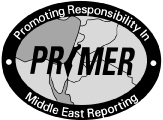You Have to Read Twice
Recent news reports about the Arab-Israeli conflict has illustrated the need for skepticism when reading newspapers, listening to the news or radio or watching it on television.For example, on June 10, 2006, The New London Day published a photo with the caption "An injured girl is treated by medics at the hospital in the northern Gaza Strip town of Beit Lahiya on Friday. Israeli gunboats fired artillery shells at targets in the area and one of the shells struck a group of civilians during a family picnic at a Gaza beach, killing nine people, including three children, and wounding more than 25 others."
There was no equivocation in The Day or any other news report: Israel had made a terrible error in one of its strikes against Palestinian Arab terrorists. An artillery shell went awry, killing innocent people at a Gaza beach.
The "moderate" Palestinian Authority leader, Mahmoud Abbas, condemned Israel for perpetrating a war crime. The radical Hamas announced it was abandoning its eighteen month old "truce," with nobody seeming to notice that it had never honored that so-called truce.
Israel, despite the painful reality that such accidents are inevitable in a battle against terrorists based in civilian areas and using them as shields, immediately expressed its regret, brought some of the injured to Israeli hospitals for treatment and suspended artillery shelling until it could learn how such a tragic mistake occurred.
Anyone reading the story just once understands the incident as just described. Those following up on the story now know the facts are quite different.
As Israel investigated the incident, it found the shrapnel in the victims had a composition incompatible with the artillery shells used by Israel, it appeared there had been no Israeli shelling at the time of the incident, and the crater on the beach had the shape of one made by an explosion from below rather than a hit from above. Combined with reports that Hamas has been mining the beach in Gaza to keep Israeli commandos from landing there, the evidence shows the deaths were almost certainly not caused by Israel, but by Hamas.
The reporting of this recent incident brings to mind the heavily publicized death, caught on film and repeatedly shown around the world, of twelve year old Mohammed Al Dura from Israeli fire September 30, 2000, near the beginning of the terrorist offensive launched by the Palestinian Arabs after rejecting peace at Camp David. His apparent death was used to fan the flames of the Palestinian Arab anger towards Israel.
Only later, and little reported, did careful investigations cast doubt on whether the incident occurred at all or was simply an elaborate hoax. Reenactments based on the film indicated it was highly unlikely that any fire from Israeli positions could have reached the youngster, so that if Al Dura was killed he was almost certainly killed by Palestinian Arab bullets rather than Israeli fire.
The truth about the Hamas-caused deaths on the Gaza beach hasn't led Mahmoud Abbas to apologize for falsely accusing Israel of war crimes; nor has it led Hamas to end its barrage of Kassam missiles aimed at Sderot or even take back its assertion "we have decided to make Sderot a ghost town." Nor have the revelations about the lack of truth in claims about the alleged death of Mohammed Al Dura and the lack of any massacre at Jenin prevented the Palestinian Arabs from using those non-events to inflame their populace.
We in America should be more discerning and learn the obvious lesson: news about terrible Israeli actions or "war crimes" must be viewed with skepticism, since it's likely to be baseless.
